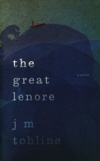The Great Lenore
Maybe women saw Lenore and despised her at first, because she was lovely to such an unfair degree. But they met her, and she was the opposite of any negative attribute they could possibly have ascribed her. She was everything they wanted her to be, and she was everything they wanted to be themselves.
Maybe women saw Lenore and despised her at first, because she was lovely to such an unfair degree. But they met her, and she was the opposite of any negative attribute they could possibly have ascribed her. She was everything they wanted her to be, and she was everything they wanted to be themselves.
Only a guy could make a statement like that. Women know Lenore. She’s the girl your parents spoke of lovingly at dinner while you were spooning up your second helping of mashed potatoes. Puberty never scarred her with fat rolls. Her grades were better. So were her SATs. The one with the job and the corner office that goes with it? That’s her. Guys have fallen under her spell since kindergarten. Her sole value to you is that she’s always been good storytelling material for you and your equally unblessed friends. Now J.M. Tohline introduces The Great Lenore, a woman possessing all those unattainable qualities parents, teachers, camp counselors, bosses, and boys adore, but who, as we girls know, is best at causing trouble.
Lenore is seen through the love-struck eyes of narrator Richard Parkland. A novelist, he is house-sitting his college roommate’s family summer home in Nantucket for the winter. Banucci Manor is no beach bungalow, and neither is the neighboring Palace, where Lenore’s in-laws, the Montanas, live:
There is nothing about the house or the view or the landscaping that says, “Look at us, we’re rich and important! We’re trying really hard.” The house is massive, and its grounds are like heaven. The view could knock you out even if you saw it every day. And nothing about it seems remotely out of place.
The set-up, between the earnest young man of working-class roots and the old-money clan—whose pretty daughter Cecilia is eager to become more than Richard’s neighbor—is already intriguing. The Montanas collect money and people. Momma Montana likes Richard because he is famous, introducing him to her other famous and well-connected friends with “the sincerest imitation of knowledgeable intimacy.”
Enter Lenore Warren Montana. A wealthy British beauty a few credits shy of a Harvard degree, she is married to Chas Montana. His brother Maxwell is literally besotted with her. Still, it is Montana financial advisor Jez who, unknown to his employers, met her first and loves her best.
Lenore enjoys manipulating those around her. When she discovers that Chas is having an affair with Lily, the boozy, busty wife of a co-worker, she fakes her death. Only Lenore doesn’t stay away, luring Richard into her game. Instantaneously, he too falls for her, describing her as “perfection” with “sensitive skin” who can “read [his] thoughts.” For a National Book Award nominee, Richard is a bit vague describing his beloved.
Thus far, The Great Lenore is no different than a novel by O’Hara or Fellowes involving socialites, DUIs, and romance. However, the outsider/narrator who becomes heavily involved in the plot, character names like Maxwell and Jez, a society wedding that should have never taken place, and the title itself evoke The Great Gatsby. There have been other fictional Lenores, with the names Guinevere, Lady Brett, Scarlett, and Queen Cersei. The one Lenore Montana most resembles is Daisy Buchanan: another reckless, spoiled rich girl causing trouble and tragedy.
Tohline’s reliance on The Great Gatsby interferes with The Great Lenore. His basic plot—boys love girl at exclusive beachfront property—was already interesting without the literary overkill. For Tohline to borrow lines from Gatsby, such as “The holocaust was complete” and “Civilization’s going to pieces,” is unnecessary, and having Richard Parkland end up in Paris rings false.
Still, this first novel shows promise. The characters, including Lenore despite the lack of an accurate physical description, are carefully drawn personalities. Tohline’s tying his Lenore to that of Edgar Allen Poe’s “Lenore” (“An anthem for the queenliest dead that ever died so young”) is far less obtrusive and makes better sense; it fits the novel’s air of mystery. Crucial moments are effectively and musically accented with the sentences, “Somewhere, a clock ticked. Somewhere, time disappeared.” Best of all are Tohline’s descriptions of writer’s block. Richard makes good use of the writing exercise of copying sentences from favorite authors:
I went inside and poured another drink. I opened my computer and tried to start writing.
Nothing came to me.
I typed the first stanza of Poe’s poem The Raven.
Once upon a midnight drearu, while I pondered, weak and
weary…
I read it.
I noticed I misspelled the word “dreary.”
I deleted the whole thing.
I stared at the blank screen, and I started all over again.
A femme fatale makes real and fictional life interesting. The Great Lenore’s twists and turns are page-turners. It is too bad that some of those surprises have been seen elsewhere. There are readers and writers alike who revere Gatsby, F. Scott Fitzgerald, and the novel’s brilliant editor Maxwell Perkins. We learn from the books we love, which is inspiration enough.





